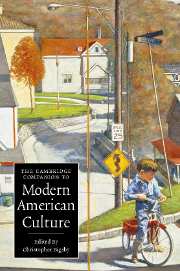Book contents
- Frontmatter
- 1 Introduction: What, then, is the American?
- 2 The American century
- 3 The regions and regionalism
- 4 Immigration to the United States in the twentieth century
- 5 Religion in the United States in the twentieth century: 1900-1960
- 6 Shifting boundaries: religion and the United States: 1960 to the present
- 7 The Hispanic background of the United States
- 8 African Americans since 1900
- 9 Asian Americans
- 10 Women in the twentieth century
- 11 Queer America
- 12 The United States, war, and the twentieth century
- 13 The culture of the Cold War
- 14 Secret America: the CIA and American culture
- 15 Vietnam and the 1960s
- 16 New York City and the struggle of the modern
- 17 Music: sound: technology
- 18 African American music of the twentieth century
- 19 Hollywood cinema
- 20 Popular culture
- 21 Theatre
- 22 Society and the novel in twentieth-century America
- 23 “Preferring the wrong way”: mapping the ethical diversity of US twentieth-century poetry
- Index
- Series List
16 - New York City and the struggle of the modern
Published online by Cambridge University Press: 28 January 2007
- Frontmatter
- 1 Introduction: What, then, is the American?
- 2 The American century
- 3 The regions and regionalism
- 4 Immigration to the United States in the twentieth century
- 5 Religion in the United States in the twentieth century: 1900-1960
- 6 Shifting boundaries: religion and the United States: 1960 to the present
- 7 The Hispanic background of the United States
- 8 African Americans since 1900
- 9 Asian Americans
- 10 Women in the twentieth century
- 11 Queer America
- 12 The United States, war, and the twentieth century
- 13 The culture of the Cold War
- 14 Secret America: the CIA and American culture
- 15 Vietnam and the 1960s
- 16 New York City and the struggle of the modern
- 17 Music: sound: technology
- 18 African American music of the twentieth century
- 19 Hollywood cinema
- 20 Popular culture
- 21 Theatre
- 22 Society and the novel in twentieth-century America
- 23 “Preferring the wrong way”: mapping the ethical diversity of US twentieth-century poetry
- Index
- Series List
Summary
Throughout the twentieth century, New York City was the supreme American example of the two powers exerted by cities - the “hard” power of finance - the world of “big men, big deals, big money, and big ideas” celebrated in Business Week - and the often intangible “soft” power of cultural and social influence. The Wall Street banker J. P. Morgan, and succeeding generations of the city's wealthy merchants, corporate moguls, bankers, and financiers, epitomized the domineering influence of finance upon the affairs of the city, and the extension of the city's influence across the globe as American wealth reached into every continent and every market. The city's cultural producers, its opinion-makers, editors, writers, and artists, an important component of the city's role as a producer and consumer of culture, played a decisive role in shaping something as intangible, and as influential as twentieth-century taste. At the heart of the city's influence lay in its success in projecting an idea or image of the city itself. The city was the home to some of the nation's most influential cultural icons. The more we learn about the creation of the Statue of Liberty, the Brooklyn Bridge, and the elegant, assertive skyscrapers which created the Manhattan skyline (from the Flatiron, to the Woolworth, Chrysler, Empire State Buildings, and the World Trade Center), the clearer it is that when it came to projecting ideas of the city through selected icons, no place in America came close to the success enjoyed by New York. In popular songs, photographs, paintings - in the multiple forms of representation - these icons defined the city and its urgent modernism.
- Type
- Chapter
- Information
- The Cambridge Companion to Modern American Culture , pp. 314 - 331Publisher: Cambridge University PressPrint publication year: 2006

